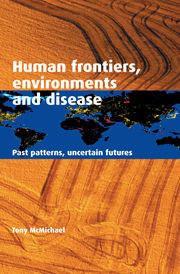Book contents
- Frontmatter
- Contents
- List of sources for illustrations
- Preface
- 1 Disease patterns in human biohistory
- 2 Human biology: the Pleistocene inheritance
- 3 Adapting to diversity: climate, food and infection
- 4 Infectious disease: humans and microbes coevolving
- 5 The Third Horseman: food, farming and famines
- 6 The industrial era: the Fifth Horseman?
- 7 Longer lives and lower birth rates
- 8 Modern affluence: lands of milk and honey
- 9 Cities, social environments and synapses
- 10 Global environmental change: overstepping limits
- 11 Health and disease: an ecological perspective
- 12 Footprints to the future: treading less heavily
- Notes
- Index
10 - Global environmental change: overstepping limits
Published online by Cambridge University Press: 05 March 2012
- Frontmatter
- Contents
- List of sources for illustrations
- Preface
- 1 Disease patterns in human biohistory
- 2 Human biology: the Pleistocene inheritance
- 3 Adapting to diversity: climate, food and infection
- 4 Infectious disease: humans and microbes coevolving
- 5 The Third Horseman: food, farming and famines
- 6 The industrial era: the Fifth Horseman?
- 7 Longer lives and lower birth rates
- 8 Modern affluence: lands of milk and honey
- 9 Cities, social environments and synapses
- 10 Global environmental change: overstepping limits
- 11 Health and disease: an ecological perspective
- 12 Footprints to the future: treading less heavily
- Notes
- Index
Summary
Human alteration of Earth is substantial and growing. Between one-third and one-half of the land surface has been transformed by human action; the carbon dioxide concentration in the atmosphere has increased by nearly 30 percent since the beginning of the Industrial Revolution; more atmospheric nitrogen is fixed by humanity than by all natural terrestrial sources combined; more than half of all accessible surface fresh water is put to use by humanity; and about one-quarter of the bird species on Earth have been driven to extinction. By these and other standards, it is clear that we live on a human-dominated planet.
Peter Vitousek and colleagues, 1997The spectrum of environmental health hazards has changed over recent centuries, most markedly in the Western world. In the eighteenth century the dominant, familiar hazards were malnutrition, occasional famine and infectious diseases. Later that century, food shortages receded as agriculture began to modernise. The urban crowding and squalor due to early industrialisation in the nineteenth century ensured the continued dominance of infectious diseases. Subsequently, however, in the twentieth century, the spectrum of environmental hazards changed; the expansion of industry, the synthesis of organic chemicals, the intensification of agriculture and the advent of motorised transport increased the levels of local pollution in air, water, soil and food. Meanwhile in low- and middle-income countries recent economic development has supplemented the persistent environmental problems of diarrhoeal disease, malnutrition, and vector-borne infections with the newer health hazards of industrialsation.
- Type
- Chapter
- Information
- Human Frontiers, Environments and DiseasePast Patterns, Uncertain Futures, pp. 283 - 317Publisher: Cambridge University PressPrint publication year: 2001



